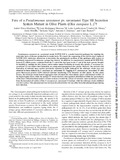Mostrar el registro sencillo del ítem
Fate of a Pseudomonas savastanoi pv. savastanoi type III secretion system mutant in olive plants (Olea europaea L.)
| dc.creator | Pérez Martínez, Isabel | es_ES |
| dc.creator | Rodríguez Moreno, Luis | es_ES |
| dc.creator | Lambertsen, Lotte | es_ES |
| dc.creator | Matas Casado, Isabel María | es_ES |
| dc.creator | Murillo Martínez, Jesús | es_ES |
| dc.creator | Tegli, Stefania | es_ES |
| dc.creator | Jiménez, Antonio J. | es_ES |
| dc.creator | Ramos, Cayo | es_ES |
| dc.date.accessioned | 2019-01-10T08:27:52Z | |
| dc.date.available | 2019-01-10T08:27:52Z | |
| dc.date.issued | 2010 | |
| dc.identifier.issn | 0099-2240 (Print) | |
| dc.identifier.issn | 1098-5336 (Electronic) | |
| dc.identifier.uri | https://hdl.handle.net/2454/31931 | |
| dc.description.abstract | Pseudomonas savastanoi pv. savastanoi strain NCPPB 3335 is a model bacterial pathogen for studying the molecular basis of disease production in woody hosts. We report the sequencing of the hrpS-to-hrpZ region of NCPPB 3335, which has allowed us to determine the phylogenetic position of this pathogen with respect to previously sequenced Pseudomonas syringae hrp clusters. In addition, we constructed a mutant of NCPPB 3335, termed T3, which carries a deletion from the 3 end of the hrpS gene to the 5 end of the hrpZ operon. Despite its inability to multiply in olive tissues and to induce tumor formation in woody olive plants, P. savastanoi pv. savastanoi T3 can induce knot formation on young micropropagated olive plants. However, the necrosis and formation of internal open cavities previously reported in knots induced by the wild-type strain were not observed in those induced by P. savastanoi pv. savastanoi T3. Tagging of P. savastanoi pv. savastanoi T3 with green fluorescent protein (GFP) allowed real-time monitoring of its behavior on olive plants. In olive plant tissues, the wild-type strain formed aggregates that colonized the intercellular spaces and internal cavities of the hypertrophic knots, while the mutant T3 strain showed a disorganized distribution within the parenchyma of the knot. Ultrastructural analysis of knot sections revealed the release of extensive outer membrane vesicles from the bacterial cell surface of the P. savastanoi pv. savastanoi T3 mutant, while the wild-type strain exhibited very few vesicles. This phenomenon has not been described before for any other bacterial phytopathogen during host infection. | en |
| dc.description.sponsorship | This research has been supported by Spanish Plan Nacional I D I grants AGL2008-55311-CO2-01 and AGL2008-55311-CO2-02, cofinanced by FEDER, as well as by Integrated Action Spain-Italy HI01-81 and by Ente Cassa di Risparmio di Firenze (2007.1005 and 2008.1573). I.P.-M. was awarded a Spanish MEC fellowship (AP2002- 3800), and L.L. and I.M.M. were supported by Carlsberg Foundation (Denmark) grant ANS-1282/20 and the Ramón Areces Foundation (Spain), respectively. | en |
| dc.format.extent | 9 p. | |
| dc.format.mimetype | application/pdf | en |
| dc.format.mimetype | application/zip | en |
| dc.language.iso | eng | en |
| dc.publisher | American Society for Microbiology | en |
| dc.relation.ispartof | Applied and Environmental Microbiology, June 2010, vol. 76, no. 11, p. 3611–3619 | en |
| dc.rights | © 2010, American Society for Microbiology. All Rights Reserved. | en |
| dc.subject | Pseudomonas savastanoi pv. Savastanoi | en |
| dc.subject | Olive plants | en |
| dc.title | Fate of a Pseudomonas savastanoi pv. savastanoi type III secretion system mutant in olive plants (Olea europaea L.) | en |
| dc.type | info:eu-repo/semantics/article | en |
| dc.type | Artículo / Artikulua | es |
| dc.contributor.department | Producción Agraria | es_ES |
| dc.contributor.department | Nekazaritza Ekoizpena | eu |
| dc.rights.accessRights | info:eu-repo/semantics/openAccess | en |
| dc.rights.accessRights | Acceso abierto / Sarbide irekia | es |
| dc.identifier.doi | 10.1128/aem.00133-10 | |
| dc.relation.publisherversion | https://doi.org/10.1128/aem.00133-10 | |
| dc.type.version | info:eu-repo/semantics/publishedVersion | en |
| dc.type.version | Versión publicada / Argitaratu den bertsioa | es |


